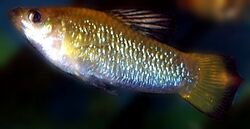Biology:Perugia's limia
From HandWiki
Short description: Species of fish
| Perugia's limia | |
|---|---|

| |
| Scientific classification | |
| Domain: | Eukaryota |
| Kingdom: | Animalia |
| Phylum: | Chordata |
| Class: | Actinopterygii |
| Order: | Cyprinodontiformes |
| Family: | Poeciliidae |
| Genus: | Limia |
| Species: | L. perugiae
|
| Binomial name | |
| Limia perugiae (Evermann & H. W. Clark, 1906)
| |
| Synonyms[2] | |
| |
Perugia's limia (Limia perugiae) is a small fish of the family Poeciliidae endemic to the Caribbean island of Hispaniola (in both Haiti and the Dominican Republic), where it occurs in streams.
Description
It grows to a length of 10 centimetres (3.9 in) TL.[2]
Taxonomy
It was described as Platypoecilus perugiae in 1906 by Barton Warren Evermann and Howard Walton Clark with a type locality given as a small stream in the San Francisco Mountains of the Dominican Republic.[3] The specific name honours the Italian ichthyologist Albert Perugia (1847-1897) of the Museo Civico di Storia Naturale di Genova in recognition of his work on West Indian fishes.[4]
References
- ↑ Lyons, T.J.; Rodríguez-Silva, R. (2021). "Limia perugiae". IUCN Red List of Threatened Species 2021: e.T125981311A125986628. doi:10.2305/IUCN.UK.2021-1.RLTS.T125981311A125986628.en. https://www.iucnredlist.org/species/125981311/125986628. Retrieved 18 November 2021.
- ↑ 2.0 2.1 Froese, Rainer and Pauly, Daniel, eds. (2019). "limia perugiae" in FishBase. August 2019 version.
- ↑ Eschmeyer, William N.; Fricke, Ron; van der Laan, Richard, eds. "Platypoecilus perugiae". California Academy of Sciences. http://researcharchive.calacademy.org/research/ichthyology/catalog/fishcatget.asp?spid=56732.
- ↑ "Order CYPRINODONTIFORMES: Families POECILIIDAE, ANABLEPIDAE, VALENCIIDAE, APHANIIDAE and PROCATOPODIDAE". The ETYFish Project Fish Name Etymology Database. Christopher Scharpf and Kenneth J. Lazara. 26 October 2019. http://www.etyfish.org/cyprinodontiformes4/. Retrieved 6 November 2019.
Wikidata ☰ Q1429252 entry
 |


